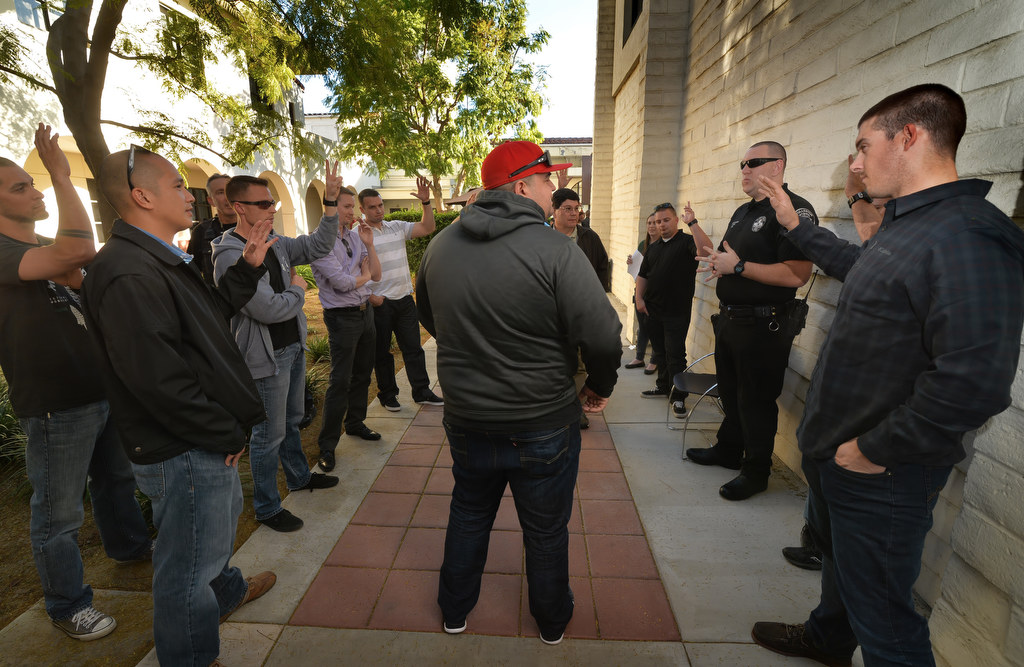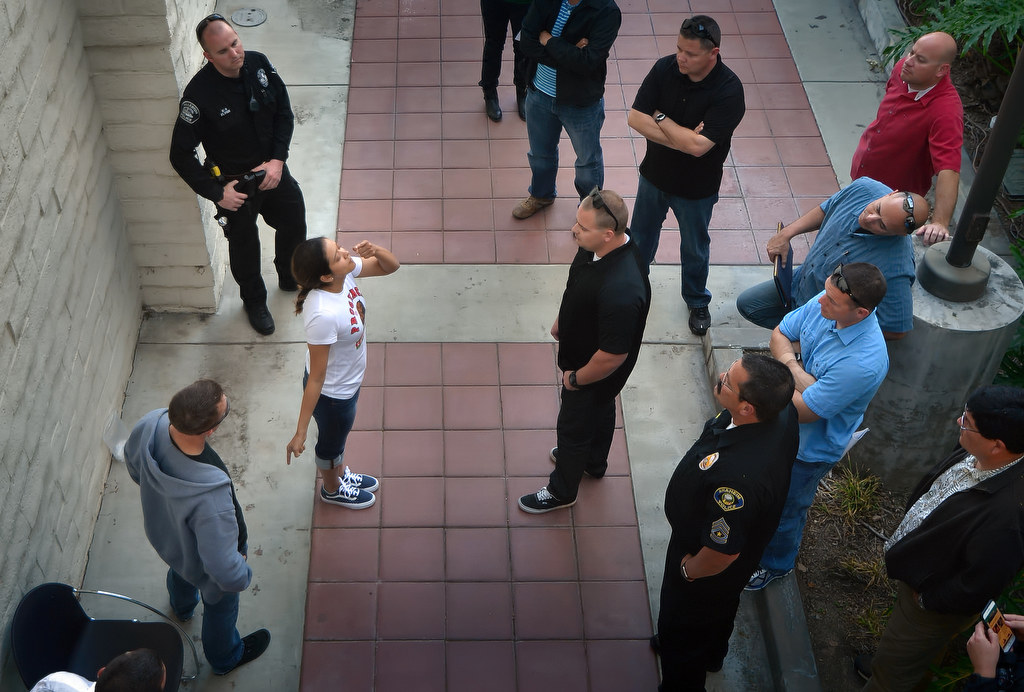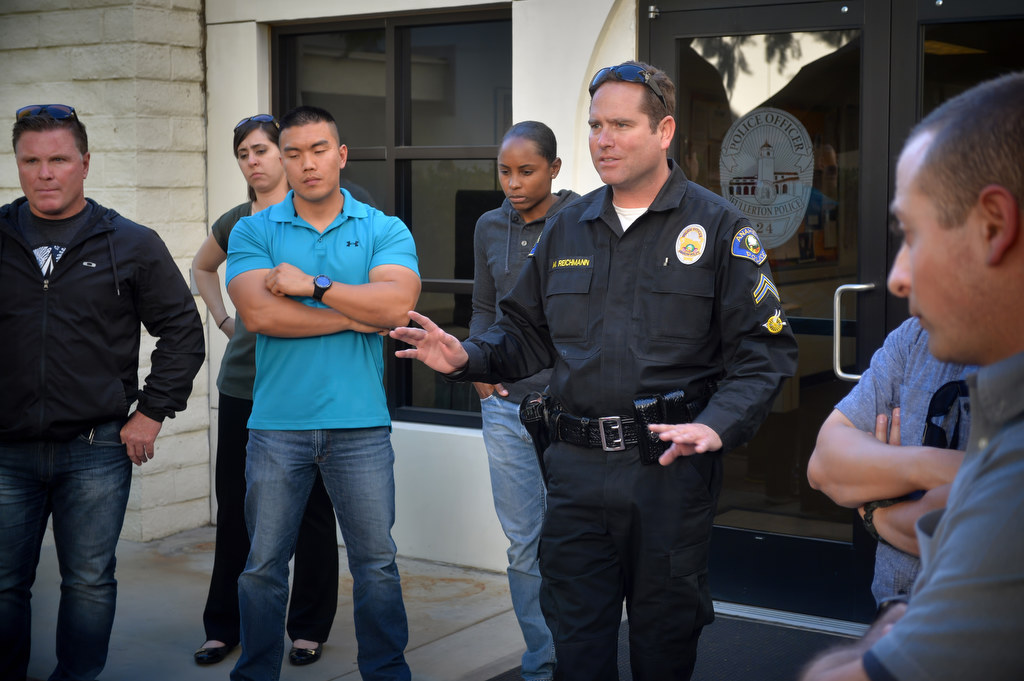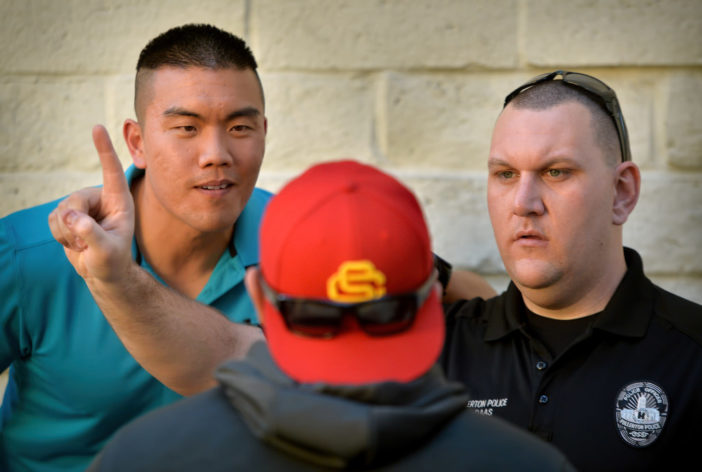He stood swaying, visibly intoxicated, surrounded by Fullerton PD officers.
The man was asked to follow the police officer’s finger from side to side.
Then he was instructed to stand on one foot with the other foot’s toe pointed while counting.
The verdict?
The dozen or so officers observing him agreed he would go to jail.
Fortunately for the man, he was serving as a volunteer — willing to be scientifically dosed to various blood alcohol concentration (BAC) levels for the purpose of officer instruction and testing.
Officers are required to get within .02 of volunteers’ BACs to pass the Wet Lab testing. The Wet Lab is only one part of the FPD’s larger DRE Program, which trains and certifies officers through a standardized process on gauging whether a person is intoxicated with alcohol and/or a specific drug or drugs.

Volunteer Victoria Rangel receives a breath alcohol test from Alicia Prater, forensic scientist for the Orange County Crime Lab, as Rangel gets ready to be tested by officers from various agencies as part of the Fullerton PD’s Wet Lab program to train Drug Recognition Experts.
Photo by Steven Georges/Behind the Badge OC
“The program teaches a systematic and validated 12-step process to reveal the potential existence of drugs, alcohol or both in a person’s system,” says Sgt. Tim Petropulos, DRE coordinator for the FPD.
“The DRE evaluates a number of objective symptoms, which include pupil size – the eyes are truly the window to the drug abuser or intoxicated person’s soul – pupil reactions to light, heart rate, body temperature, blood pressure, etc.”
Petropulos says because of the thorough process, accuracy levels among DRE officers are high — so much so that officers often are called to testify as expert witnesses in court cases, including those for vehicular homicides, rape, child molestation and murder.
“DRE officer training focuses heavily on the reduction of impaired drivers, but it also is valued [and]used elsewhere,” Petropulos says.
A Unique Program
According to Officer Eric Franke, who helps run the DRE Program with Petropulos, the program was born out of necessity as a response to the 1960s drug culture.

Officers from various agencies gather to watch volunteer Carlos Medina (red hat) as the officers administer a sobriety test to him during the Fullerton PD’s Wet Lab program.
Photo by Steven Georges/Behind the Badge OC
“In the United States, the late 1960s witnessed the emergence of the illicit drug-consuming, underground subculture into more open and close association with the general law-abiding and sober society, resulting in a gamut of new challenges for law enforcement and the judiciary, particularly in California,” he says.
“For over five decades since its inception, the DRE program has trained and influenced thousands of law enforcement officers, police administrators, prosecutors, state and federal government legislators, lobbyists and others to meet the ever-growing and evolving problems of protecting the public on the highways, and the public interest in the courtrooms across our nation.”
The FPD is unique in that it is the only police agency in Orange County offering DRE training (however, it is an international standardized program taught by many other agencies outside the county and state).
At the recent Wet Lab, officers in attendance came from a variety of agencies, including Anaheim, Tustin, Costa Mesa, Ontario and Orange, as well as deputies from the Riverside County Sheriff’s Department.
High Standards
Typically, about 50 students each year attend Fullerton’s DRE school, which is conducted annually.

Tustin PD Officer Jeremy Laurich administers a sobriety test to volunteer Mary Smith as other officers watch.
Photo by Steven Georges/Behind the Badge OC
The prerequisites for DRE training are Standardized Field Sobriety Test (SFST) and Advanced Roadside Impaired Driving Enforcement (ARIDE).
SFST involves three tests: Horizontal Gaze Nystagmus (HGN), One-Leg-Stand and the “Walk & Turn.” It’s a three-day classroom course consisting of a Wet Lab.
ARIDE is a two-day training focusing on both legal and illegal drugs that impair driving.
“The first part of [DRE] training consists of two weeks of rigorous classroom instruction,” says Petropulos. “The program has just added a new 8-hour block of mental illness training. The classroom portion also includes two Wet Labs. Each and every training block is taught by DRE instructors.”
Community experts assist in other training blocks, including prosecutors from the Orange County District Attorney’s Office who instruct on courtroom testimony, physicians teaching the physiology section and members of the Orange County Crime Lab handling the toxicology block.

PD officers gather around volunteer Carlos Medina (red hat) as they are asked what they observed during a sobriety test taken by Medina.
Photo by Steven Georges/Behind the Badge OC
The second half of training consists of Field Certifications in which students are required to apply classroom knowledge to actual arrestees suspected of being under the influence of one of the drugs from seven categories (depressants, stimulants, hallucinogens, dissociative anesthetics, narcotic analgesics, inhalants and cannabis).
Numerous drugs fall into each category – for example, alcohol as well as prescription anti-anxiety drugs fall under the depressants category.
“Stimulants are what we see the most of in Orange County,” says Petropulos. “That and cannabis.”
But DRE officers still have to know the less-common drugs being used in the area as well, including hallucinogens like Bath Salts, which has received some notoriety for intense violence being a side effect, and Spice, a type of synthetic cannabis, according to Franke.
“We’ve had people do full-on dance routines lying on the ground,” says Franke of reactions to Spice.
Needless to say, DRE training is intense and ongoing, since officers must keep up with what’s trending.

Volunteer Victoria Rangel is given a sobriety test from officers during the Fullerton PD’s Wet Lab program.
Photo by Steven Georges/Behind the Badge OC
Says Petropulos: “DRE-trained officers must go through a recertification course every two years and conduct evaluations to make sure the integrity of the program is intact and the officers receive updates on new drug trends and/or modifications [to]the DRE protocol since the drug problem in this world is dynamic and technology is advancing.”
DRE in Action
There are countless “war stories,” as Franke calls them, in which the DRE training has paid off.
There was an incident involving a solo vehicle collision in which the driver’s car crashed into a retaining wall after crossing several lanes of opposing, oncoming traffic.
“When I arrived I saw the driver, a young male business professional dressed in a suit and tie [who]was standing and talking to fire department personnel and other officers on the scene,” says Franke. “Because the driver was unable to provide any believable explanation as to how this collision occurred, I candidly took a 30-second pulse from his left wrist and recorded a heart rate of 142 beats per minute — which is incredibly fast for a normal heart rate, which typically stays between 60-90 beats per minute for someone not physically exerting themselves.”
After a few more field sobriety tests, DRE training told Franke that the driver was under the influence of a strong central nervous system stimulant and he placed the driver under arrest for DUI drugs.
“Contrary to my instincts, which were telling me as they did the other officers and paramedics on scene, there was nothing to suspect of this driver,” Franke says. “But after placing handcuffs and before placing him into my patrol car, I searched his outer clothing for weapons or contraband and suddenly my beliefs were validated as I removed a clear ‘gram’ bottle filled with cocaine from inside of his right front pant pocket.”

Anaheim PD Officer Mike Reichmann administers a sobriety test to a volunteer.
Photo by Steven Georges/Behind the Badge OC
DRE training is equally as vital in the courtroom, since DRE expert witnesses are almost always called to testify on driving-related criminal cases, says Franke.
He recalls a case when a young male driver with his 5-year-old son in the car drove across four lanes of oncoming traffic without ever reacting or attempting to correct his course, killing a 3-year-old girl in a stroller and seriously injuring her father.
“The driver never made any effort to step on the brake or change his course, calmly exits his car, hides his marijuana and pipe near a wall nearby, then returns to his car, sits down and begins texting on his cell phone, making [no]attempt to help others on the scene lift his car off of the 3-year-old crushed underneath,” says Franke. “At trial his defense was a ‘momentary distraction’ while talking to his son in the backseat. His blood results returned positive for a powerful prescription anti-depressant, marijuana and other drugs.”
There was no on-scene DRE exam, so speaking on behalf of the training and research provided by the DRE protocol and published studies funded by the National Highway Traffic Safety Administration, the prosecution was able to educate the jury regarding the mind-altering characteristics of the drugs found in the driver’s bloodstream and how those characteristics closely matched the behavior of the driver leading up to and after the collision. The result was a guilty verdict of felony drunk driving, manslaughter and other charges, says Franke.
A Community Effort
The FPD’s DRE Program is funded by a grant through the Office of Traffic Safety (OTS). Various members of the community who are experts in their field teach some DRE courses.
Courses like the Wet Lab also involve community members.
At the recent Wet Lab, one of the volunteers was a practicing criminal defense attorney. Plus, the OC Crime Lab handles all the alcohol dosing at the Wet Lab, including forensic scientists keeping close tabs on each volunteer’s BAC levels.
In other words, the DRE Program is a community effort, and one that greatly serves the community in return.
“It’s been a wonderful collaboration between FPD, the OCCL and the OCDA Office,” says Petropulos.
“We just don’t see other counties within the country that work so closely together in such a progressive fashion. OTS has previously referred to this as the model collaboration/program for the country to try to attain.”
 Behind the Badge
Behind the Badge



